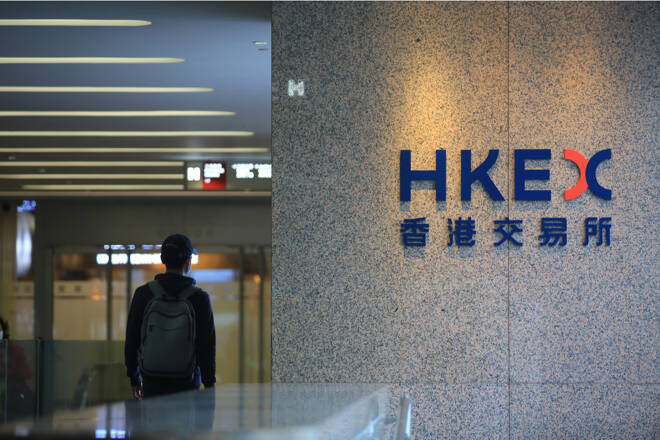Advertisement
Advertisement
Hang Seng Index: Strong China GDP and Trade Tensions Drive Market Divergence
By:
Key Points:
- US markets tumbled as Trump raised tariffs on China, while Powell signaled slower growth and sticky inflation.
- The Hang Seng Index snapped a five-week losing streak, lifted by stimulus hopes and strong Chinese data.
- China’s Q1 GDP beat forecasts at 5.4%, with strong gains in retail sales and industrial production.
US Markets Drop on Trade Developments and a Hawkish Powell
US markets suffered losses in the week ending April 18 as the US-China trade war intensified and Fed Chair Powell warned of slower growth and higher prices. The Nasdaq Composite Index dropped 2.62%, while the Dow and the S&P 500 fell 2.66% and 1.50%, respectively.
President Trump unsettled investors by raising tariffs on select Chinese imports to 245% and imposing export restrictions on chips to China, sending Nvidia (NVDA) down 8.51% for the week. He also launched an investigation into potential tariffs on crucial minerals and their derivative products.
Despite pressure on aviation, Boeing (BA) rose 3.23%, shrugging off China’s call for airlines to halt further deliveries.
In the bond markets, 10-year US Treasury yields dropped 16 basis points to end the week at 4.333%, recovering from a low of 4.263%. Meanwhile, the US Dollar Index fell 0.47%, extending its losing streak to four weeks.
Tariff developments and Powell’s comments overshadowed upbeat US retail sales and labor market data.
China Economy Surprises Amid Policy Pledges
China reported GDP growth of 5.4% year-on-year for Q1 2025, beating a 5.1% consensus and matching Q4 2024 growth despite the US tariff hikes earlier in the year.
March data showed strong momentum:
- Retail sales jumped 5.9% year-on-year (YoY) after rising 4% in January and February.
- The unemployment rate fell from 5.4% in February to 5.2% in March.
- Industrial production rose 7.7% YoY in March, up from 5.9% in January and February.
While higher production may reflect the front-running of tariffs, rising consumer activity and job gains suggest policy support remains effective. Nonetheless, economic uncertainty looms. A prolonged US-China trade war could impact China’s labor market, domestic demand, and the economy. During the week, Morgan Stanley cut its 2025 growth forecast from 4.5% to 4.2%, while UBS projected 3.4%.
Hang Seng Index Gains on China Data and Stimulus Hopes
The Hang Seng Index ended a five-week losing streak, climbing 2.30% on better-than-expected data and stimulus hopes. China’s Ministry of Commerce, Ministry of Industry and Information Technology, and PBOC officials will reportedly attend a Monday briefing to outline service sector expansion plans.
Still, trade developments and economic uncertainty capped the gains.
- Tech giants Alibaba (09988.HK) and Baidu (09888.HK) posted weekly gains of 5.53% and 4.36%, respectively.
- EVs were mixed: Li Auto (02015.HK) fell 0.55%, while NIO Inc. (09866.HK) rallied 4.99%.
Mainland China’s equity markets also snapped an extended run of weekly losses. The CSI 300 rose 0.59%, while the Shanghai Composite Index gained 1.19% amid fresh stimulus signals.
Brian Tycangco of Stansberry Research noted the US and the Hong Kong market divergence, stating:
“Hong Kong’s key indices are rallying today even after Wall Street’s big losses overnight. Decoupling takes many forms. This could be the shape of things to come if Beijing is able to sustain growth through stimulus and focus on keeping things stable at home.”
For more analysis on the Hang Seng Index and global market trends, click here.
Commodities Diverge on Tariff News
- Gold extended gains, striking a record high of $3,358 before closing at $3,327, up 2.75% for the week. Powell’s comments and tariff risks continued driving demand.
- WTI crude oil prices rallied 4.48% to $63.495 on higher demand from China, while iron ore spot prices slipped 0.40% amid economic uncertainty.
ASX 200 Diverges from US Markets
The ASX 200 rose 2.26% in the week ending April 18. Rising gold and oil prices drove commodity-related stocks higher while falling US Treasury yields boosted demand for high-yielding Aussie banks.
- Woodside Energy Group Ltd. (WDS) gained 2.24%.
- Northern Star Resources Ltd. (NST) rallied 4.44%, extending its winning streak to seven weeks.
- Commonwealth Bank of Australia jumped 4.25%, logging a five-week winning streak.
Nikkei Gains on Trade Optimism
The Nikkei Index ended the week up 2.13%, buoyed by progress in US-Japan trade talks. President Trump cited ‘big progress,’ boosting hopes of a deal. Markets have long speculated that Trump’s tariff policies are targeting China. Despite a stronger Yen, export-linked stocks held firm. The USD/JPY fell 0.93% to 142.108 in the week.
- Nissan Motor Corp. (7201) gained 0.82%.
- Fast Retailing Co. Ltd. (9983), Uniqlo’s parent company, rose 3.38%.
- Sony Corp. (6758) rallied 6.12%.
Looking Ahead: Beijing, Trade Talks, and Central Banks
Investors should closely monitor updates from Beijing ahead of the NPC Standing Committee Meeting (April 27-30), which will review the private sector promotion bill. Trade developments and central bank commentary also need consideration. The key question is whether the US and China will begin dialogue.
In a volatile environment, staying informed on geopolitical and policy developments remains crucial. Access deeper Hang Seng insights here.
About the Author
Bob Masonauthor
With over 28 years of experience in the financial industry, Bob has worked with various global rating agencies and multinational banks. Currently he is covering currencies, commodities, alternative asset classes and global equities, focusing mostly on European and Asian markets.
Did you find this article useful?
Latest news and analysis
Advertisement
